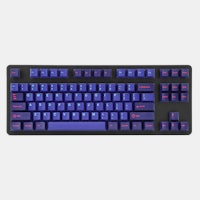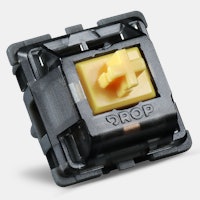Click to view our Accessibility Statement or contact us with accessibility-related questions






3 or 5? How many pins does your switch really need?
One of the oldest questions, albeit one you don’t see very often anymore, is about 3-pin and 5-pin MX switches. Early in the custom switch scene, budding enthusiasts would need to determine whether their keyboard needs 3-pin or 5-pin switches. Today, the question doesn’t appear as often as it used to, but it is still important to know the difference and when one is a better choice.
The difference between these two types of switches is in the name, the number of pins. As seen in the pictures below, 3-pin switches have two metal legs for the contact leaves and registering of switch presses as well as the stem pole. These switches were traditionally called plate mount switches, as they relied on the plate to align the switches on the PCB. 5-pin switches have the same contact pins and stem pole but are also accompanied by two additional alignment pins on the left and right of the stem pole. These were called PCB mount switches, as they could be used without plates as the PCBs would have holes to accommodate the alignment pins.






search
close
Sort by: Newest
keyboard_arrow_down
artnude
0
Apr 7, 2024
I have really just started getting into custom keyboards and haven't really tried a lot of switches but right now I am enjoying hand lubed Kailh Box White switches with PBT caps in a Drop Sense75 with the brass base weight, POM plate and several simple mods. I am mostly a gamer but the linear switches just didn't have the sound and feel I liked.
PRODUCTS YOU MAY LIKE
Trending Posts in Mechanical Keyboards
leoakaleo
callboy job chennai
Have you ever considered a profession that blends excitement, charm, and independence? Call boy jobs in Chennai present a unique opportunity for those ready to explore a different career path. With...
Dec 30, 2024
nienow.donny
Chill Out with Fun: Dive into Papa's Freezeria Game!
Are you ready to take a break from reality and indulge in a delicious virtual ice cream adventure? Welcome to the sweet world of Papa's Freezeria! In this delightful game, you'll transform into a master ice cream chef, serving up yummy concoctions to your quirky customers while managing your very own ice cream shop. Grab your aprons, unleash your creativity, and get ready to scoop, blend, and serve! What is Papa's Freezeria? Papa's Freezeria is a fun-filled cooking simulation game where players run an ice cream parlor by preparing and serving delicious treats. From building the perfect sundae to creating refreshing milkshakes, this game brings the art of ice cream making right to your fingertips! But hold on—having fun isn’t just about tasty flavors; it’s also about mastering the art of multitasking and keeping your customers happy. How to Play: Your Guide to Delicious Success! Step 1: Get Started Getting started is easy! You can choose between various characters, each with their...
Dec 30, 2024
MoreBlcvk
Can i someone support me in fixing my Drop Alt keyboard?
I havent used this keyboard in months. When I plug it in, it turns on and turns off. You would assume there is a short in the cord but I know there's not because I can use the cord with a different keyboard. So do you think its a firmware issue or a short inside the keyboard? Either way I want to fix it. Any suggestions or tips & tricks?
Dec 29, 2024
CapnKitten
Solid ABS Keycaps
DCX quality is pretty good. Similar sound signature and a smoother texture to GMK. Not a dig at either, just a difference. Ignore the missing keycap, it's a switch issue.
Dec 29, 2024

excelsiorcarslondon
Why Cab Service Near Me is Essential in Today’s Fast-Paced World
In today’s world, convenience is key. Whether you're commuting to work, heading to an important meeting, or enjoying a night out, having access to a reliable london city airport transfers is indispensable. Companies like Excelsior Cars London are redefining what it means to travel conveniently and efficiently. The Importance of Local Cab Services When you're in a hurry or unfamiliar with your surroundings, searching for a “cab service near me” can be a lifesaver. Local cab services bridge the gap between affordability and reliability, providing quick solutions for transportation needs. Unlike app-based ride-sharing platforms, traditional cab services often offer: Instant Availability: No long wait times during peak hours. Knowledgeable Drivers: Drivers familiar with local routes and shortcuts. Personalized Service: A customer-focused experience that prioritizes your comfort. Excelsior Cars London, for example, ensures passengers experience stress-free travel with their fleet of...
Dec 27, 2024
















